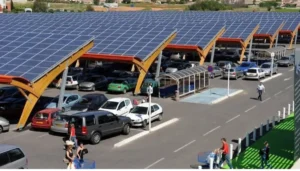Solar Stock a Price Increase
On Friday, analysts were buzzing about a solar stock that received a price target increase, as well as Nike, which faced a downgrade after earnings. Solar-related stocks First Solar (NASDAQ: FSLR), SunPower (NASDAQ: SPWR), and Sunnova Energy (NYSE: NOVA) experienced significant gains.
- First Solar: UBS analysts raised their price target on First Solar to $270. They predict the solar panel manufacturer’s earnings will increase from $7.74 last year to $36.74 by 2027. First Solar’s leading “thin film” solar technology positions it well for industrial utility-scale deployments, especially for AI data centers.
- SunPower: While SunPower is more focused on residential solar, it may be seeing a surge due to its newfound reputation as a meme stock. With the return of Roaring Kitty (the person behind the meme stock era), SunPower’s stock soared. Previously, 64% of its float was sold short, contributing to its recent rally.
- Sunnova Energy: Sunnova recently introduced its “virtual power plant” product, allowing residential customers to send stored power back to the grid during peak demand periods. As data centers expand, the electrical grid will play a crucial role, indirectly benefiting companies like Sunnova.
Investment in Solar Stocks
Investing in solar stocks can be a smart move, especially considering the long-term potential in the age of climate change. Here are some solar power stocks:
- Enphase Energy Inc. (ENPH): With a market cap of $17.1 billion, Enphase Energy is a leader in solar microinverters. Their technology optimizes solar panel performance and reliability.
- Brookfield Renewable (BEP): This company focuses on renewable energy, including solar. With a market cap of $7.9 billion, it’s worth exploring their investment opportunities.
- Sunrun (RUN): Sunrun is a residential solar provider with a market cap of $3.1 billion. They offer solar leases and power purchase agreements (PPAs) for homeowners.
- SolarEdge Technologies (SEDG): SolarEdge specializes in power optimizers and inverters. Their market cap is $2.8 billion, and they’re well-positioned in the solar industry.
- Array Technologies (ARRY): With a market cap of $2.1 billion, Array Technologies focuses on solar tracking solutions. Their technology improves solar panel efficiency by following the sun’s path.
- Canadian Solar (CSIQ): Canadian Solar, with a market cap of $1.3 billion, is a global solar panel manufacturer. They operate in various markets worldwide.
- Sunnova Energy (NOVA): Sunnova, with a market cap of $604 million, offers residential solar and energy storage solutions. Their virtual power plant product is gaining attention.

Risks of Investing in Solar Stocks
When considering investing in solar stocks, it is essential to be aware of both the potential benefits and the risks. Here are some key points to keep in mind:
- Market Volatility: Like any investment, solar industry stocks can be affected by market volatility. Factors such as changes in government policies, fluctuations in energy prices, and competition within the renewable sector can influence stock performance.
- Supply Chain Challenges: The solar industry relies on precious metals for various components, including panels and batteries. Shortages of these materials can lead to increased production costs and delays.
- Industry Volatility: The solar industry is still evolving and experiences fluctuations. While there’s promise for growth, it is essential to be prepared for industry ups and downs.
Long-term Trends in the Solar Industry
- Global Growth: Analysts estimate that 2023 global solar installations reached around 440 GWdc, an 89% increase over 2022 installations. Cumulative global capacity now stands at approximately 1.6 TWdc. China played a significant role, deploying around 250 GWdc of solar.
- U.S. Deployment: In the United States, 26 GWac (33 GWdc) of PV were installed in 2023, marking a 46% year-on-year increase. Residential, non-residential, and utility segments all contributed to this growth.
- Advancements in PV Technology: Ongoing advancements in photovoltaic (PV) technology continue to make solar panels more efficient and cost-effective. Expect solar panels with greater energy output per unit area of installation.
- Interest Rates and Financing: Interest rates impact solar loans and sales. As rates fall, the industry adapts to maintain growth.
- Third-Party Ownership: Third-party ownership models gain traction, allowing more consumers to access solar energy without upfront costs.
- Storage Solutions: The push for energy storage solutions continues, enhancing solar system reliability and grid integration.
- Solar Maintenance: As solar installations age, maintenance services become crucial for optimal performance and longevity.
- Net Metering Challenges: Net metering policies face scrutiny, impacting how solar users are compensated for excess energy fed back into the grid.
Read also:1) “Texas Roadhouse Rolls: Now Available in Walmart Freezer Aisles”, But only in 3 States
2)“Walk with Legends: IndusInd’s Anthem Buddies Contest” during ICC Men’s T20 World Cup 2024
For more news: Click Here



